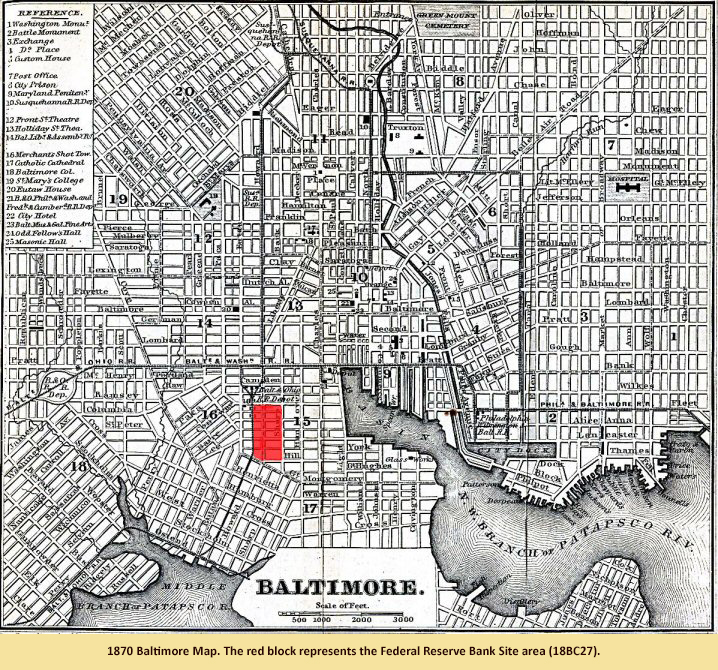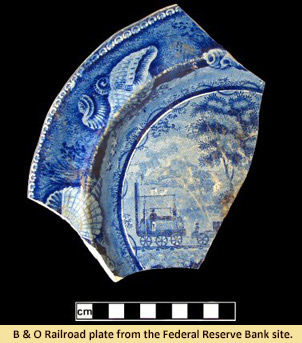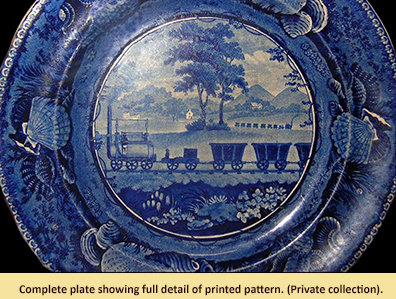B&O Railroad Plate
November 2009
By Patricia Samford, MAC Lab Director
In the early nineteenth century, the area several blocks west of Baltimore's Harbor was a thriving working class neighborhood, filled with row
houses of the type still standing in many parts of the city. The uniform street-side appearance of these row houses belied the busy
yards behind them. These enclosed yards, used as extensions of home living spaces, were crowded with work yards, privies, henhouses and other small buildings.

 A good look at some of these urban back lots was gained in 1980 during archaeological excavations conducted by Mid-Atlantic Archaeological
Research, Inc. prior to the construction of the Federal Reserve Bank (18BC27). Excavations revealed a number of wells and privy
pits dating to the first half of the nineteenth century. Abandoned wells and privies often became handy dumping areas for all manner of household garbage.
One privy, Feature 30, was no exception. In addition to the food bones, broken medicine bottles, buttons, tobacco pipes, peach pits
and other debris, the feature yielded an artifact relevant to the history of the city and the state.
A good look at some of these urban back lots was gained in 1980 during archaeological excavations conducted by Mid-Atlantic Archaeological
Research, Inc. prior to the construction of the Federal Reserve Bank (18BC27). Excavations revealed a number of wells and privy
pits dating to the first half of the nineteenth century. Abandoned wells and privies often became handy dumping areas for all manner of household garbage.
One privy, Feature 30, was no exception. In addition to the food bones, broken medicine bottles, buttons, tobacco pipes, peach pits
and other debris, the feature yielded an artifact relevant to the history of the city and the state.
Approximately one third of a plate printed with a dark blue design was removed from the privy. The central design, encircled by a border of seashells,
was of an early steam locomotive. A little library research revealed that this pattern was entitled "The Baltimore & Ohio Rail Road"
and was manufactured by the English pottery firm of Enoch Wood & Sons.
In the 1820s, Baltimore was the nation's third largest city, competing with New York and Philadelphia for trade to the Midwest. The Baltimore
and Ohio Railroad, one of the oldest railroads in the country, was established to facilitate the movement of trade goods over the Allegheny
Mountains to the Ohio and Mississippi Rivers. The first thirteen mile stretch of railroad opened in May of 1830 (Wortham 1939). While
the first train cars were pulled by horses,steam locomotives were in use by 1831.
 The "Baltimore and Ohio Rail Road" pattern was probably first produced by potters Enoch Wood & Sons in the late 1820s or early 1830s, to commemorate
the laying of the first rails or the actual opening of the railroad itself (Halsey, 1899; Snyder 1995). The actual pattern was based
on an engraving of the British Hetton Railroad and first published in The American Traveller Broadside in 1826 (Dunbar 1915). Between
1815 and 1840, many Staffordshire potters appealed specifically to the American market by producing pottery depicting American landmarks,
such as churches, hotels and resorts, homes, city vistas, and natural wonders.
The "Baltimore and Ohio Rail Road" pattern was probably first produced by potters Enoch Wood & Sons in the late 1820s or early 1830s, to commemorate
the laying of the first rails or the actual opening of the railroad itself (Halsey, 1899; Snyder 1995). The actual pattern was based
on an engraving of the British Hetton Railroad and first published in The American Traveller Broadside in 1826 (Dunbar 1915). Between
1815 and 1840, many Staffordshire potters appealed specifically to the American market by producing pottery depicting American landmarks,
such as churches, hotels and resorts, homes, city vistas, and natural wonders.
What makes this find particularly poignant is that the row houses whose residents purchased and used the B&O plate were destroyed in
the early twentieth century by the Baltimore and Ohio Railroad Company in order to expand Camden Yard.
| References |
|
| Dunbar, Seymour |
| 1915 |
A History of Travel in America. Bobbs-Merrill, Indianapolis. |
|
| Halsey, R.T. Haines |
| 1899 |
Pictures of Early New York on Dark Blue Staffordshire Pottery; Together with Pictures of Boston and New England, Philadelphia, the South and West. New York. |
|
| in |
| 1939 |
Staffordshire and the Baltimore and Ohio. American Collector. December 1939. |
|
| Snyder, Jeffrey B. |
| 1995 |
Historical Staffordshire; American Patriots and Views. Schiffer Publishing, Atglen, Pennsylvania. |
|